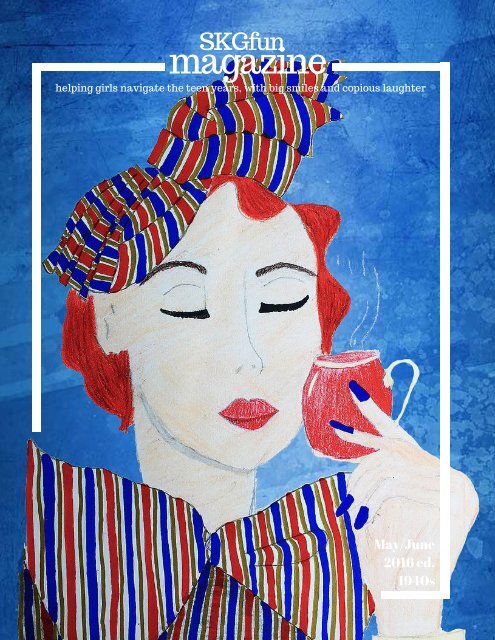SKGfun5_3
Explore the 1940s with vivid writing featuring World War II, "the forces sweetheart," toe-tapping music, funky words, and more!
Explore the 1940s with vivid writing featuring World War II, "the forces sweetheart," toe-tapping music, funky words, and more!
You also want an ePaper? Increase the reach of your titles
YUMPU automatically turns print PDFs into web optimized ePapers that Google loves.
SKGfun<br />
magazine<br />
helping girls navigate the teen years, with big smiles and copious laughter<br />
May/June<br />
2016 ed.<br />
1940s
SKG fun<br />
M A Y - J U N E 2 0 1 6<br />
CONTRIBUTORS<br />
JULIA FINDLEY / SARAH MARGARET / CAROLINE<br />
MILBURN / VIRGINIA HIGUERA / KORBYN GRIFFITH /<br />
JULIA RYAN / EMMA GOLDSTROM / CLARA RYDER / EMMA<br />
BIGELOW / KYLIE JACOBS / AMANDA BROWN / RACHEL<br />
BROWN<br />
Volume No. 5, Issue No. 3<br />
W W W . S K G F U N . C O M
TABLE OF CONTENTS<br />
SKG FUN<br />
THEME: THE 1940S<br />
Remember This Destination Unknown 03<br />
Kids At War 06<br />
The Runway '40s Style<br />
07<br />
Armistice Day Blizzard 11<br />
17<br />
"The Forces Sweetheart"<br />
15<br />
American Involvement<br />
in WWII: How It<br />
Started and Ended<br />
Behind the Movie It's A Wonderful Life 18<br />
A Victory Dinner 20<br />
Wartime Swing 21<br />
Credits 23<br />
Front cover: Girl Wearing a Hat by Rachel Brown<br />
Useless Facts 12<br />
Makeup Bin 14<br />
4 Divine Desserts 16<br />
22<br />
'40s Dictionary<br />
Visit<br />
to view this current issue on your<br />
computer<br />
SKGFUN.COM
SKG FUN<br />
EDITOR'S NOTE<br />
Amanda Brown<br />
E D I T O R - I N - C H I E F<br />
Whenever I hear about the '40s, World War II instantly<br />
comes to mind. Growing up, I owned a Molly McIntire<br />
American Girl doll. This historical doll was themed around<br />
the 1940s, and owning her roused a curiosity in me about her<br />
time period. Therefore, I studied the '40s with a hilarious<br />
intensity.<br />
At the age of eleven, I could list all the countries that made up<br />
the Axis and Allies. I also knew all the major world leaders<br />
and the type of government they had forced on their people.<br />
I knew all about victory gardens, Rosie the Riveter, war<br />
bonds, and metal drives.<br />
Well, now it's your turn to learn all about the 1940s. I hope<br />
you enjoy the journey as much as I have!<br />
Happy reading!<br />
Amanda Brown<br />
S K G F U N | 2
REMEMBER THIS<br />
MAY/JUNE 2016<br />
SKGFUN.COM<br />
Destination Unknown: A<br />
Look at the 1940s<br />
by Julia Ryan<br />
Beginning Thoughts<br />
I almost regretted taking the job of<br />
writing this article. I wasn’t aware that<br />
putting World War II into words would<br />
be so difficult and depressing. The<br />
death tolls for the Allied armies<br />
(including the United States, United<br />
Kingdom, France, China, and the Soviet<br />
Union) reached 14,201,000, whereas<br />
the Axis death (Germany and Japan) toll<br />
hit 7,674,000.<br />
The men who fought were not the only<br />
men who died.<br />
Civilian allied deaths were 24,042,000<br />
men, woman and children. Germany<br />
and Japan lost 3,080,000 civilian lives.<br />
And, through Concentration Camps<br />
alone, nearly 12,000,000 people died.<br />
12 million.<br />
I wasn’t ready for these facts. I guess the<br />
main jist of my article is let's not forget<br />
about war and death and hatred, but<br />
don’t carry it in your heart.<br />
War destroys people and lives. And yet<br />
ometimes it is necessary to protect our<br />
freedom and goodness from the forces<br />
of evil. But let’s always remember to<br />
“fight the good fight" (1 Timothy 6:12).<br />
The main jist is<br />
let's not forget<br />
about war and<br />
death and hatred,<br />
but don't carry it in<br />
your heart.<br />
"Fight the<br />
good fight . . ."<br />
(1 Timothy<br />
6:12)<br />
S K G F U N | 3
REMEMBER THIS<br />
MAY/JUNE 2016<br />
SKGFUN.COM<br />
Franklin D. Roosevelt<br />
was still president of the United States<br />
of America in the early 1940’s. He had<br />
made a career out of conquering<br />
difficulties. Polio changed his life in<br />
1921, the Great Depression was a huge<br />
obstacle, and now war was ready to<br />
break loose. FDR was the man that<br />
everyone wanted in office – but would<br />
he throw his hat back into the ring for<br />
the third time?<br />
Winston Churchill<br />
was a large part of London’s side in the<br />
War. As friends, FDR and Churchill had<br />
both been naval officers during World<br />
War I, and they both now were<br />
considered heads of state. They<br />
connected on a level of how to bring<br />
out the best during the worst of times.<br />
Churchill saw what danger Adolf Hitler<br />
posed to his country, and he also knew<br />
that the Prime Minister of Britain<br />
wasn’t ready for war – he was a<br />
peaceful man. It took Germany’s<br />
invasion of Norway in the early 40’s for<br />
the honest truth to hit home. Within<br />
months, Winston Churchill became<br />
Prime Minister.<br />
Adolf Hitler<br />
The name that makes everyone cringe.<br />
He, like FDR, loved to talk and stir up<br />
emotions in the people around him.<br />
But, while Roosevelt encouraged good<br />
feelings, Adolf Hitler fed the anger and<br />
hatred of his people. He delivered<br />
speeches that were full of old folk<br />
sentiment, racist slurs, and xenophobia<br />
(DEFINITION: a major dislike for<br />
foreigners) that literally stirred the<br />
Germans into frenzy. Like Churchill<br />
and FDR, Hitler also fought in World<br />
War I. He walked away with an Iron<br />
Cross for bravery, but then joined a<br />
group of unhappy nationalists<br />
(DEFINITION: pro-independence men)<br />
and formed the Nazi Party.<br />
"FDR was the man<br />
that everyone<br />
wanted in<br />
POSTMODERN<br />
PAINTING. Stella<br />
alternately paints in<br />
oil and watercolor<br />
office...but would<br />
he throw his hat<br />
back into the ring<br />
for the third time?"<br />
After being jailed in 1923 for trying to<br />
overthrow Bavaria’s republican<br />
government, Adolf Hitler wrote Mein<br />
Kampf. Basically, it was a book trying to<br />
blame World War I on the Jewish<br />
people and Marxists. Not until 1929<br />
(when a major depression hit Germany)<br />
did this movement become popular.<br />
Hitler was then named chancellor of<br />
Germany.<br />
With swift efficiency, he seized control<br />
over every facet (DEFINITION: side,<br />
aspect, party) of the German state,<br />
instating anti-Semitic laws, and<br />
building concentration camps in hidden<br />
places to liquidate his enemies. Adolf<br />
Hitler was preparing for war.<br />
S K G F U N | 4
REMEMBER THIS<br />
MAY/JUNE 2016<br />
SKGFUN.COM<br />
Pearl Harbor<br />
1:40 p.m. on Sunday, December 7th,<br />
1941, the abrupt telegram arrived at the<br />
White House.<br />
“AIR RAID PEARL HARBOR – THIS IS<br />
NO DRILL.”<br />
A Japanese strike force of six aircraft<br />
carriers and a potent support force<br />
began its ruthless and deadly convey of<br />
353 planes. To hold on to that power,<br />
they first bombed where the U.S. planes<br />
were closely held, wing to wing. Then<br />
they swooped down to send merciless<br />
torpedoes down to the Battleship Row.<br />
The brave navy crewmen were stunned.<br />
Aboard the dying West Virginia, an<br />
attendant, Doris Miller, ran topside to<br />
drag his mortally injured friend to<br />
protected cover and then grabbed a<br />
machine gun and shot down four<br />
enemy planes. The attack was so<br />
overpowering though, that within two<br />
hours the U.S. had suffered dreadful<br />
loses. More than 2,400 servicemen<br />
were killed. No less than 347 planes<br />
were destroyed. Eight battleships, three<br />
destroyers and three cruisers were sunk<br />
or damaged.<br />
Since Pearl Harbor (a bay in the<br />
southern coast of Hawaii) was the home<br />
base for the U.S Fleet, the thought of an<br />
attack was a common one for military<br />
planners. How to actually achieve it had<br />
been the question posed to every<br />
graduated class at the Japanese naval<br />
academy since 1931. Additionally, the<br />
U.S ambassador to Japan had been<br />
warned of talk that a surprise attack<br />
may be attempted against Pearl Harbor.<br />
But FDR and Churchill only shortly<br />
considered this. They were busy with<br />
Hitler.<br />
"A Japanese strike<br />
force began its<br />
ruthless and<br />
deadly convey of<br />
353 planes."<br />
On the day after Pearl Harbor was<br />
attacked, President Roosevelt stood<br />
before a joint session of Congress. He<br />
asked “that the Congress declare that<br />
since the unprovoked and dastardly<br />
attack by Japan . . . a state of war has<br />
existed.” Within a few short hours, a<br />
declaration of war was decided on.<br />
Being Shipped Out<br />
When war was declared, countless<br />
young men rushed to join some<br />
military recruiting station. In the first<br />
week after Pearl Harbor, the army, navy<br />
and marines signed up nearly 25,000<br />
recruits. In Detroit, three generations of<br />
the same family showed up to enlist in<br />
the navy on the same day. One<br />
high-school student in Philadelphia<br />
wanted to be a fighter pilot in the Army<br />
Air Corps, so he ate so many carrots<br />
that his skin turned a bright orange.<br />
These men and boys were determined<br />
to protect the country which they held<br />
so dear.<br />
On December 22, Franklin Roosevelt<br />
signed a law that required all males<br />
18-65 to sign up to fight. All four of<br />
Roosevelt’s sons were already officers<br />
in the armed forces and on his own<br />
60th birthday, the president himself got<br />
a draft card.<br />
Recruits were swallowed up by the<br />
world of inch-long needles and<br />
half-inch haircuts, uniforms that rarely<br />
fit, and shoes that constantly needed<br />
attention, as well as the endured night<br />
marches, record breaking yelling<br />
sergeants, and "degrading" duty of KP,<br />
aka “Kitchen Duty."<br />
Marriage rates sky rocketed after the<br />
attack on Pearl Harbor. It is estimated<br />
that 1,000 women a day were marrying<br />
servicemen. Some new wives attempted<br />
tostay close to their husbands by taking<br />
housing near the training stations. But,<br />
too quickly came the day that the men<br />
had to be shipped overseas to battle.<br />
Wives and families could do little more<br />
than wait and pray, trying to imagine<br />
what their loved ones were dealing<br />
with. Everyone dreaded the telegram<br />
that began with, “We regret to inform<br />
you . . .”<br />
On the Home Front<br />
Photo by Ryan McGuire<br />
By 1944, the U.S industry was<br />
producing a B-24 every hour, a jeep<br />
every two minutes, and 50 percent<br />
more weaponry and artillery than the<br />
Axis pwers. For many of the workers,<br />
the payoff was personal.<br />
S K G F U N | 5
LET'S PLAY MAY/JUNE 2016<br />
SKGFUN.COM<br />
One seaman named Elgin Staples<br />
wrote that his life belt had saved<br />
him from drowning when his ship<br />
sunk. He later found a stamp on the<br />
belt informing him that it had been<br />
made in his hometown – and<br />
inspected and packaged by his own<br />
mother.<br />
With so many men overseas, the<br />
women of America stepped up to<br />
the need of factory workers and<br />
rocked the house. Between 1940 to<br />
1944, the number of woman<br />
employees raised from 12 million to<br />
18.2 million.<br />
"Elgin Staples wrote that<br />
his life belt had saved<br />
him . . . he later found a<br />
stamp on the belt informing<br />
him that it had been made<br />
in his hometown and<br />
inspected and packaged<br />
by his own mother."<br />
Many of those ladies were<br />
encouraged by the “We Can Do It!”<br />
poster. However, many people gave<br />
these hard working women a<br />
difficult time, saying that “a woman<br />
is a substitute, like plastic instead of<br />
metal.” Despite the horrid<br />
criticisms, these women proved the<br />
government workers wrong.<br />
Hiroshima and Nagasaki<br />
The atomic bomb had been an idea<br />
for a long time. The origin dates<br />
back to a letter FDR received from<br />
Albert Einstein in 1939. The idea<br />
was if atoms were split “the element<br />
uranium may be turned into a new<br />
and important sort of energy.” The<br />
project was so secretive that Harry<br />
Truman didn’t even know about<br />
it until the day after he was sworn<br />
into the Presidential Office.<br />
Within a few short months,<br />
Truman was ready to end this<br />
war. On August 6th, at 8:15 a.m.,<br />
the atomic bomb known as Little<br />
Boy was released. Nearly 100,000<br />
people were killed that day.<br />
Perhaps double that would die<br />
later due to burns and the effects<br />
of radiation.<br />
When the Japanese leaders didn’t<br />
respond to the attack, Truman<br />
ordered the release of the 2nd<br />
atomic bomb called, Fat Man on<br />
August 9th. The immediate death<br />
toll reached 35,000 in an instant.<br />
Those bombs did such terrible,<br />
terrible damage.<br />
The End<br />
Emperor Hirohito was done.<br />
After the devastating bombing<br />
from the United States and Russia<br />
neither he nor his country could<br />
continue their arrogant struggle<br />
against freedom. He intervened<br />
with his Supreme War Council<br />
and said, “The time has come, we<br />
must bear the unbearable.”<br />
The U.S agreed to the Japanese<br />
offer of unconditional surrender<br />
with the emperor remaining on<br />
his throne. On August 14th,<br />
President Truman made the<br />
declaration to the world.<br />
Kids At War<br />
B y E m m a B i g e l o w<br />
In the 1940s, America was at war.<br />
Therefore, military planes, troops,<br />
and news of bloody battles wasn't a<br />
stranger to the kids who lived<br />
during this time period.<br />
Most boys considered the<br />
sea-battling troops to be heroes.<br />
They loved to pretend to be pilots<br />
of planes like Kittyhawk or<br />
Lockheed Lightning.<br />
For girls, dolls and other toys were<br />
scarce, except for those passed<br />
down from older children. Some<br />
girls even pieced toys together<br />
from wood, buttons, and other<br />
small items.<br />
Sometimes kids had to hide under<br />
a bomb shelter for long hours<br />
before clear. This was scary<br />
because many children were afraid<br />
of the dark and loud sounds. In<br />
addition, it was difficult for<br />
children to watch their parents<br />
deal through the tragedy of war.<br />
But through the years, children<br />
remained children, and God<br />
remained God, and that’s what’s<br />
important.<br />
S K G F U N | 6
'40S<br />
STYLE<br />
THE RUNWAY<br />
The 1940s were a very innovative time for women’s fashion<br />
because of World War II.<br />
Flip the page to discover the style of the '40s.
THE RUNWAY MAY/JUNE 2016<br />
SKGFUN.COM<br />
B y R a c h e l B r o w n<br />
I l l u s t r a t i o n s b y<br />
R a c h e l B r o w n<br />
Dresses/skirts<br />
Because of the extra fabric that<br />
was needed for the war, most<br />
skirt hemlines were raised to<br />
the knee. Almost all dresses<br />
were fitted with shoulder pads<br />
and slightly puffed sleeves to<br />
create boxy shoulders, while the<br />
bottom featured an A-line skirt.<br />
In the early years of the decade,<br />
most dresses were extremely<br />
simple, with no pockets, sashes,<br />
or extra fabric added anywhere<br />
to the dress because of the<br />
rationing of fabric. However,<br />
towards the end of the 1940s,<br />
pockets, sashes, and other<br />
elements were added back to<br />
many dress styles.<br />
to Welcome<br />
'40s the<br />
The 1940s were a very<br />
innovative time for<br />
women’s fashion because<br />
of World War II. Because<br />
the military needed a lot of<br />
wool and cotton, many<br />
women had to be<br />
resourceful and make use<br />
of the other types of<br />
fabrics they had, such as<br />
rayon and American<br />
cotton.<br />
Typically, the clothes were<br />
styled to emphasize or<br />
create the hour-glass<br />
figure, with broad<br />
shoulders, narrow waists,<br />
and full hips. Shoulder<br />
pads, cinched waists, and<br />
A-line skirts helped<br />
achieve this look.<br />
S K G F U N | 8
THE RUNWAY MAY/JUNE 2016<br />
SKGFUN.COM<br />
Suits<br />
With many women going to work in the<br />
1940s, the need for dressier and more<br />
practical wear arose; thus, the women’s suit<br />
was invented, often called “the Victory<br />
suit.” Most outfits consisted of a suit coat<br />
on top, with a cinched waist and shoulder<br />
pads; an A-line skirt, flaring out slightly<br />
from the hip to the knee; and sometimes a<br />
blouse underneath, although it wasn’t<br />
necessary to wear one under the suit coat.<br />
Although it looked better to have a<br />
matching suit coat and skirt, most women<br />
wore them mismatched because that was<br />
all they could afford.<br />
Pants<br />
Because of the need for a more practical<br />
and comfortable wear, pants gradually<br />
became acceptable for women to<br />
wear. When the war first started, women<br />
would wear their husband's old pants to<br />
work; however, as the times wore on,<br />
designers made pants specially designed<br />
for ladies. They were often made of cotton,<br />
denim, or wool; had high waists; and flared<br />
out slightly at the bottoms. Eventually,<br />
women would start wearing pants even<br />
after work hours, just for fun!<br />
S K G F U N | 9
Accessories<br />
THE RUNWAY MAY/JUNE 2016<br />
SKGFUN.COM<br />
Hats<br />
Hats were still very popular in this era, with<br />
the fedora becoming a big trend. Most<br />
fancy hats were largely decorative and<br />
had big flowers, while scarves were<br />
used to tie up hair during work. Most<br />
of these hair scarves were made of silk<br />
with hand-painted patterns.<br />
Coats<br />
Surprisingly, coats were big and boxy<br />
during this time, with huge bell sleeves.<br />
Fox was the “must-have” material for<br />
coats!<br />
Shoes in the 1940s were a lot less detailed<br />
than in the previous decades; however,<br />
because leather was needed for the war,<br />
many shoes were made with exquisite<br />
materials, such as reptile skins, velvet,<br />
mesh, and even wood. The shoes were<br />
made chunkier with short, thin heels<br />
(pumps).<br />
Shoes<br />
S K G F U N | 1 0
WHETHER WEATHER MAY/JUNE 2016<br />
SKGFUN.COM<br />
The Armistice Day<br />
Blizzard<br />
B y J u l i a R y a n<br />
The Armistice Day Blizzard took<br />
place in the Midwest area of the<br />
United States on November 11-12 of<br />
1940. This intense early-season<br />
winter storm covered 1,000 miles,<br />
flying through the middle of the U.S<br />
from Kansas to Michigan.<br />
The morning of November 11<br />
brought oddly warm temperatures<br />
across the affected areas, reacing up<br />
to the mid 60s F. As the day<br />
progressed on, the temperatures<br />
dropped drastically and the winds<br />
became stronger. Soon, sleet<br />
followed rain and then snow began<br />
to fall from the sky. A strong low<br />
pressure system had moved from<br />
the southern plains into westerns<br />
Wisconsin, bringing the Gulf of<br />
Mexico moisture from the south and<br />
freezing air from the north.<br />
The mixture brought a raging<br />
blizzard that would continue on into<br />
the next day. Snowfall records hit 27<br />
inches as winds reached 50 to 80<br />
mph. Seeing 20-foot snow drifts was<br />
common, and 50 degree<br />
temperature drops occurred in<br />
Nebraska, Iowa, Wisconsin,<br />
Minnesota, South Dakota, and<br />
Michigan<br />
Medical transportation and<br />
communication between<br />
people was nearly impossible,<br />
making it difficult to find the<br />
injured and dead. In Lake<br />
Michigan, 66 sailors died due to<br />
the freezing temperatures. In<br />
Watkins, Minnesota, two people<br />
died after two trains collided in<br />
the blinding white snow.<br />
Along the Mississippi River,<br />
several hundred duck hunters<br />
took advantage of the warm<br />
weather, which provided<br />
for perfect fir duck hunting.<br />
Since the weather had not<br />
predicted any sort of nasty cold<br />
storm, they hadn’t dressed for<br />
bad weather.<br />
As the storm began, many<br />
hunters tried to seek shelter on<br />
small islands. The 50 mph<br />
winds brought 5 foot waves to<br />
them. Many men became<br />
stranded on the islands and<br />
died to the single digit<br />
temperatures. The duck<br />
S K G F U N | 1 1
USELESS FACTS MAY/JUNE 2016<br />
accounted for nearly half of the 49<br />
deaths on Minnesota alone.<br />
Two brave men, Max Conrad (a pilot<br />
and flight school owner) and his<br />
friend John Bean, flew up and down<br />
during the storm, finding survivors<br />
and dropping survival supplies to<br />
them. Both men were nominated<br />
the Carnegie Medal for their<br />
heroism.<br />
Additionally, 1.5 million turkeys<br />
meant for Thanksgiving dinners<br />
within the next few weeks, perished<br />
due to the cold weather exposure.<br />
No joke.<br />
Useless Facts<br />
C o m p i l e d b y C l a r a R y d e r a n d C a r o l i n e M i l b u r n<br />
Warning! This article contains<br />
unbelievable information so get<br />
ready to sit on the edge of your seat<br />
and be amazed.<br />
1940<br />
A Wild Hare, a Bugs Bunny film,<br />
releases<br />
Ladies' nylons are introduced<br />
1941<br />
Captain America and Superman<br />
comic books release<br />
M&M’s, jeeps, and cheerios invented<br />
1942<br />
T-shirt invented<br />
1943<br />
Rodgers & Hammerstein’s musical<br />
Oklahoma! opens<br />
1944<br />
Ballpoint pens invented<br />
1945<br />
Slinky and microwave oven<br />
invented<br />
First computer built<br />
1946<br />
It’s a Wonderful Life premieres<br />
1947<br />
Polaroid camera is invented<br />
Dead Sea Scrolls are discovered<br />
Jackie Robinson joins the Dodgers,<br />
becoming the first black baseball<br />
player in the Major Leagues<br />
1949<br />
Silly putty is invented<br />
Airplane flies around world (no<br />
stops)<br />
S K G F U N | 1 2
MAKE<br />
UPBIN<br />
GET THE 40S LOOK<br />
Written by Julia Findley<br />
Illustrations by Rachel Brown<br />
Although the '40s were a war time, women still used their makeup.<br />
Red lipstick kisses could be found on a letters to sweethearts fighting<br />
overseas. Flip the page for a peek into a '40s makeup bag.
MAKEUP BIN MAY/JUNE 2016<br />
A bright red lipstick, or a peachy<br />
natural shade. Some went for a matte<br />
color.<br />
Nail painting was<br />
not as popular.<br />
Keeping your nails<br />
filed to a point was<br />
more important.<br />
A dark eyebrow pencil filled in the<br />
natural arch. This look is very<br />
different from today's, which is<br />
more squared off and plucked into<br />
“perfection” or “fleek”.<br />
Mascara came back<br />
into use, and it was<br />
bigger than ever!<br />
During this time,<br />
winged eye liner became<br />
popular. Typical 40s eye<br />
shadow was more subtle<br />
but accentuated eye<br />
color. When going out<br />
at night, most women<br />
went for a smokey<br />
eye.<br />
A foundation that was a<br />
shade darker than your<br />
natural skin color made you<br />
look healthy and young, as<br />
if you had been out in the<br />
sun. Rosy blush added to<br />
the healthy look.<br />
This was when the<br />
smokey eye look<br />
became popular, and it<br />
is now one of the most<br />
used looks.<br />
S K G F U N | 1 4
BATTLE BITES MAY/JUNE 2016<br />
SKGFUN.COM<br />
AMERICAN INVOLVEMENT<br />
IN WWII<br />
why it started and how it ended<br />
By Virginia Higuera<br />
While every war has its major battles, perhaps the most important<br />
ones are the first and the last--the first conflict, to show why a<br />
war began, and the last, to see how it ended and if it was worth it.<br />
History repeats, and it’s the job of those in the present to<br />
examine the events of the past and learn from them. And in the<br />
case of WWII, there is a lot to be learned.<br />
Pearl Harbor<br />
December 7, 1941<br />
The attack on Pearl Harbor, Hawaii was the act that<br />
finally brought the United States into World War II.<br />
Before that fateful day in December, the majority of<br />
Americans were against joining the war.<br />
Unfortunately, there was a powerful man in<br />
America who did everything he could to ensure the<br />
American people getting involved: President<br />
Franklin Delano Roosevelt (FDR). After several of<br />
his actions intended to provoke Germany failed to<br />
change the American people’s stance on war, FDR<br />
turned his attention to the east.<br />
While the conflict between China and Japan was<br />
mostly separate from the fighting in Europe, Japan<br />
joined the Axis powers so that they could<br />
attack—and conquer—European colonies in East<br />
Asia. In order to incite the Japanese, FDR froze<br />
Japanese assets, banned oil trades with Japan, and<br />
refused negotiation. The Japanese were left with<br />
two choices: submit to the unfair demands of the<br />
American government or fight to regain those<br />
needed resources. The Japanese Prime Minister,<br />
General Tojo, chose the latter and decided to make<br />
the attack swift and deadly. On a quiet Sunday<br />
morning, the American naval forces stationed at<br />
Pearl Harbor were suddenly attacked by<br />
Japanese aircraft. Less than two hours later,<br />
twenty-one ships, 188 planes, and nearly three<br />
thousand Americans were destroyed. With<br />
Congress’ approval, FDR declared war on Japan and<br />
the American people joined forces with the Allies.<br />
Normandy Invasion (D-Day)<br />
June 6, 1944<br />
While fighting with Japan raged in the Pacific,<br />
German forces were slowly losing their control of<br />
Europe. The Allies came up with a plan to finally<br />
defeat Germany. The plan of attack, code named<br />
“Operation Overlord,” was to land on the beaches in<br />
Nazi-occupied France.<br />
It was the largest military strike ever made against<br />
the German forces. The Germans would then have<br />
to fight the American and British soldiers attacking<br />
from the west in addition to Russian troops from<br />
the east. Under the command of General Dwight<br />
Eisenhower, more than five thousand ships and ten<br />
thousand aircraft were sent to the beaches in<br />
Normandy.<br />
Although the main attack came from the sea,<br />
paratroopers played a key role in the invasion of<br />
S K G F U N | 1 5
BATTLE BITES MAY/JUNE 2016<br />
SKGFUN.COM<br />
Normandy. Soldiers wearing parachutes and<br />
dummies dressed as soldiers were dropped from<br />
airplanes behind enemy lines. These soldiers were<br />
meant to secure important exit locations, while also<br />
confusing the Germans and distracting them from<br />
the larger, maritime assault. At the end of the day,<br />
the beach was theirs. It came with a high price:<br />
more than five thousand Allied soldiers lay dead.<br />
This first battle, called “D-Day,” was the first in a<br />
series of battles for France and marked the<br />
beginning of the end of German power. Not long<br />
after, Russian soldiers marched into Berlin and<br />
Germany surrendered, ending the war in Europe.<br />
Bombings of Hiroshima<br />
and Nagasaki<br />
August 6 and 9, 1945<br />
they prevented many more years of American<br />
blood being shed. No one can dispute the atomic<br />
bombs’ efficiency, however, as Japan surrendered<br />
just five days later. WWII was over, once and for<br />
all.<br />
Even after the Germans surrendered, the Japanese<br />
continued fighting. The war had dragged on for<br />
years, and the Allied leaders were desperate for a<br />
quick end.<br />
Back in 1941, at the start of American involvement<br />
in the war, scientists were experimenting with a new<br />
weapon: a bomb that would split atoms, creating a<br />
giant explosion. When they successfully built an<br />
atomic bomb, scientists tested it in New Mexico.<br />
One scientist described the scene: “a tremendous<br />
cloud of smoke was pouring upwards, some parts<br />
having brilliant red and yellow colors, like clouds at<br />
sunset.”<br />
They delivered news of their success to President<br />
Truman and he gave his approval for the use of this<br />
deadly bomb on Japan. The first target was the<br />
Japanese city of Hiroshima. Immediately after the<br />
bomb hit the ground, thousands of people died.<br />
Before then, no one had ever seen a bomb with<br />
such power. No one had ever seen a bomb that<br />
could flatten an entire city.<br />
Americans dropped a second bomb, earning the<br />
same results as the first. There is still debate on<br />
whether it was right to use the atomic bombs and,<br />
consequently, kill thousands of civilians. Some<br />
would argue that the bombings were justified, as<br />
S K G F U N | 1 6
GIRL NOOK<br />
SKGFUN.COM MAY/JUNE 2016<br />
"The Forces Sweetheart"<br />
By Clara Ryder<br />
The early 1940s and the call to arms meant<br />
poverty and heartbreak were never far<br />
away. But the nation of England’s spirit<br />
never faltered, strengthened in particular<br />
by one young woman who provided the<br />
troops of World War II with<br />
encouragement and support. Her music<br />
provided a connection to home and<br />
inspiration to keep defending their<br />
country.<br />
This brave young woman was Vera<br />
Margaret Welch, born in East Ham,<br />
London, in 1917 to Bertram and Annie<br />
Welch. She started performing at age 7<br />
and took her grandmother's<br />
name, Lynn, as her stage name. She<br />
preformed in restaurants and clubs<br />
throughout her high school years until her<br />
first radio broadcast with the Joe Loss<br />
Orchestra when she was 18 years old. This<br />
led to her being featured on records of the<br />
Joe Loss Orchestra and Charlie Kunz.<br />
In 1941 during the darkest hours of World<br />
War II, Vera began her own radio show<br />
called "Sincerely Yours" where she sang<br />
songs soldiers most often requested. Two<br />
of the most popular songs were "The<br />
White Cliffs of Dover" and "We’ll Meet<br />
Again."<br />
Vera also took messages from young<br />
mothers to their husbands overseas and<br />
broadcasted them. During this time, she<br />
visited Egypt, India and Burma to<br />
entertain and preform for the troops,<br />
providing them with encouragement and a<br />
connection to home. The soldiers loved<br />
Vera Lynn, and she was ranked the most<br />
favored musical performer among the<br />
soldiers during the war. They came to<br />
know her as “the Forces Sweetheart.”<br />
That same year, Vera married Harry<br />
Lewis, a musician who played saxophone<br />
and clarinet for many London bands. A<br />
few years later she had her first and only<br />
child, Virginia Penelope Anne Lewis.<br />
Although she had started a family, her<br />
musical career continued. Now, however,<br />
she was not only known for her music. She<br />
starred in a number of movies and TV<br />
shows such as “Rhythm Serenade”, “One<br />
Exciting Night” and "We’ll Meet Again”,<br />
the latter based loosely on Vera's life as a<br />
singer.<br />
Vera recorded many more songs such as<br />
“Auf Widerseh’n Sweetheart,” “It Hurts To<br />
Say Goodbye,” “My Son, My Son,” and<br />
many more. In the 60s and 70s, Vera<br />
continued to preform and also became<br />
involved with several war veteran social<br />
causes. In 1953, Vera Lynn established the<br />
cerebral palsy charity for children, known<br />
as the SOS (The Stars Organization for<br />
Spastics), for which she became<br />
chairperson and later the president. To<br />
recognize all the effort she had invested in<br />
England through the war years, Queen<br />
Elizabeth made her a dame in 1975.<br />
Vera sang for the Queen and in<br />
Buckingham Palace several times, such as<br />
when she sang at the ceremony marking<br />
the golden jubilee of VE-Day.<br />
Dame Vera Lynn, currently age 99, lives in<br />
Sussex England. She has given up her<br />
musical career and has taken up the craft<br />
of watercolor. Her life still shines to others<br />
around her, reflecting pride for her nation,<br />
love and compassion for others, and the<br />
things she taught the world about<br />
humanity, war, joy and love.<br />
“I never claimed<br />
to be a great<br />
singer, but I’ve<br />
always given my<br />
best, and I’ve<br />
loved what I’ve<br />
done, and had a<br />
very good life.”<br />
S K G F U N | 1 7
BEHIND<br />
THE<br />
THE CHRISTMAS MOVIE WE ALL KNOW AND LOVE MIGHT NOT HAVE<br />
BEEN IF FRANK CAPRA HADN'T READ THE ORIGINAL STORY, "THE<br />
GIFT" (WRITTEN BY PHILIP VAN DOREN STERN) AND SAW ITS<br />
GREATEST<br />
POTENTIAL.<br />
WRITTEN BY SARAH MARGARET<br />
FLIP THE PAGE
NOW SHOWING<br />
SKGFUN.COM MAY/JUNE 2016<br />
“Strange, isn't it?<br />
Each man's life touches so many other lives.<br />
When he isn't around he leaves an awful hole, doesn't he? ”<br />
RKO Pictures had previously tried to make<br />
a movie based on the story, and had<br />
created three unsatisfactory scripts before<br />
shelving the planned movie. Therefore,<br />
RKO was anxious to unload the project.<br />
In 1945 they sold the rights to Capra's<br />
production company, Liberty Films, for<br />
$10,000 and threw in the three scripts for<br />
free. Capra along with his writers polished<br />
the script and combined useful material<br />
from the three scripts into a screenplay<br />
Capra would rename It's A Wonderful Life.<br />
The movie starred Jimmy Stewart and<br />
Dona Reed, who both came from small<br />
towns. Donna Reed proved this by<br />
winning an impromptu bet with Larry<br />
Barrymore when he challenged her to<br />
milk a cow on set.<br />
Filming started on April 15, 1946, and<br />
ended on July 27, 1946. The film went into<br />
general release on January 7th, 1947, and<br />
was placed 26th. $3.3 million was made in<br />
box office revenues for 1947. In<br />
comparison, the film recorded a loss of<br />
$525,000 at the box office for RKO.<br />
It's A Wonderful Life is a Christmas classic<br />
that everyone enjoys, adults and children<br />
alike.<br />
S K G F U N | 1 9
SCRUMDIDDLYUMPTIOUS SNACKS<br />
SKGFUN.COM MAY/JUNE 2016<br />
A Victory Dinner<br />
By Kylie Jacobs<br />
Back in the 1940s, World War II was just ending. Many stay-at-home moms where up late preparing<br />
meals for their children, dreaming of the day when their husbands would come home. Many of these<br />
meals we can still cook today! Why don’t you pretend you are cooking a meal waiting for your<br />
husband, but instead cook it for your parents! Here is a meal plan for dinner tonight!<br />
Cola Marsh Ice<br />
Ingredients<br />
- 24 marshmallows<br />
- 2 cups cola beverage<br />
- 1/8 tsp salt<br />
- 2 tbsp lemon juice<br />
Instructions<br />
1. Place marshmallows and 2 tbsp. cola in saucepan.<br />
2. Heat slowly, folding over and over until<br />
marshmallows are about half melted.<br />
3. Remove from heat and continue folding until<br />
mixture is smooth and fluffy.<br />
4. Cool slightly, then add remaining cola, salt, and<br />
lemon juice.<br />
5. Blend thoroughly.<br />
6. Pour into ice tray and freeze until firm, stirring<br />
2 or 3 times while freezing.<br />
(Serves 4 or 5)<br />
Sweet-Sour Carrots<br />
Ingredients:<br />
- 2 tbsp butter<br />
- 2 tbsp flour<br />
- 1/2 tsp salt<br />
- Pepper<br />
- 2 tbsp sugar<br />
- 2 tbsp vinegar<br />
- 1 cup hot water<br />
- 4 cups cooked carrots<br />
Instructions:<br />
1. Brown butter, blend in flour, and continue browning,<br />
stirring constantly.<br />
2. Add seasonings.<br />
3. Combine sugar, vinegar, and water and add gradually;<br />
cook slowly until thickened, stirring constantly.<br />
4. Pour over hot carrots.<br />
(Serves 6 to 8.)<br />
Deviled Chicken Recipe<br />
Ingredients<br />
- 1 broiling or frying chicken<br />
- Salt and pepper<br />
- 1/2 cup fat, melted<br />
- 2 tbsp flour<br />
- 1 cup hot water or soup stock<br />
- 1 1/2 tsp dry mustard<br />
- 2 tsp Worcestershire sauce<br />
- 2 tsp tomato ketchup<br />
- Paprika<br />
Instructions<br />
1. Allow 3/4 lb. chicken per person. Cut chicken into serving portions, season with salt and pepper, and brown in<br />
melted fat; remove from pan.<br />
2. Stir flour into fat; cook until mixture browns and thickens, stirring constantly.<br />
3. Add hot water or soup stock and next four ingredients to cooked sauce.<br />
4. Place chicken in sauce, cover pan, and simmer until tender, about an hour.<br />
S K G F U N | 2 0
TUBULAR TUNES<br />
SKGFUN.COM MAY/JUNE 2016<br />
Wartime Swing<br />
By Korbyn Griffith<br />
–<br />
–<br />
Bing Crosby<br />
Only Forever<br />
Choo Glenn Miller<br />
Choo Chattanooga<br />
–<br />
–<br />
Bing Crosby<br />
White Christmas<br />
Smile Again Frank Sinatra<br />
Never I’ll<br />
– Me In Bing Crosby & The<br />
Don’t Fence<br />
Sisters Andrews<br />
–<br />
–<br />
Star Bing Crosby<br />
Swinging on a<br />
Sunshine Jimmie Davis<br />
My Are You<br />
–<br />
–<br />
Your Land Woody Guthrie<br />
This Land is<br />
Pearls Glenn Miller<br />
of String A<br />
Auld Lang Syne – Guy Lombardo<br />
S K G F U N | 2 1
WORD NERD<br />
SKGFUN.COM MAY/JUNE 2016<br />
'40s Dictionary<br />
By Emma Bigelow<br />
The 1940s was very interesting when it came to words that they used. There was a wide variety<br />
of slang—such as<br />
"Khaki wacky" (boy crazy)<br />
"Doll dizzy" (girl crazy)<br />
"Eager beaver" (ready to help; this<br />
one is still around!)<br />
"Snap your cap" (get angry)<br />
"Stompers" (shoes)<br />
Motorized freckles (bugs/insects)<br />
Some words that were added to the dictionary in the 1940s included<br />
this one makes me want<br />
to laugh!<br />
Baby blues<br />
Airlanded<br />
Autoload<br />
Cassoulet<br />
Con (which can be used as "He's a con<br />
artist" or "he went to a con," as in<br />
convention")<br />
S K G F U N | 2 2
CREDITS MAY/JUNE 2016<br />
SKGFUN.COM<br />
The SKGfun magazine only comes<br />
out bimonthly . . .<br />
B u t t h e r e ' s m o r e f u n a t<br />
skgfun.com<br />
Two weekly blog posts to<br />
encourage and inspire<br />
Access to previous SKGfun<br />
e-magazines<br />
Beautiful review videos with real<br />
opinions<br />
Fun wallpapers<br />
Opportunity to share your writing<br />
in SKGfun<br />
Learn about SKGfun's purpose<br />
Meet other writers like you<br />
Credits<br />
a.k.a, boring stuff<br />
Battle Bites<br />
Bauer, S. Wise., and Sarah Park. "The Second World War and The End of<br />
World War II." The Story of the World. from Victoria's Empire to the End<br />
of the USSR. Charles City, VA: Peace Hill, 2005. 305-27. Print.<br />
History.com Staff. "D-Day." History.com.<br />
A&E Television Networks, 01 Jan. 2009. Web. 21 Apr. 2016.<br />
"Paratroopers." PBS. PBS, n.d. Web. 21 Apr. 2016.<br />
Woods, Thomas E., Ph.D. "The Approach of World War II." The Politically<br />
Incorrect Guide to American History. Washington, D.C.: Regnery Pub.,<br />
2004. 174-81. Print.<br />
"USS SHAW exploding during the Japanese raid on Pearl Harbor."<br />
December 7, 1941. 80-G-16871.<br />
President Franklin D. Roosevelt signing the Declaration of War against<br />
Japan, December 8, 1941. 79-AR-82.<br />
Girl Nook<br />
http://www.biography.com/people/vera-lynn-21229673<br />
https://en.wikipedia.org/wiki/Vera_Lynn http://www.telegraph.co.uk<br />
/culture/music/10739326/Dame-Vera-Lynn-interview-People-usedme-to-achieve-something.-I-was-just-doing-my-job.html<br />
Scrummdiddlyumptious Snacks<br />
https://delishably.com/food-industry/A-1940s-Menu-Food-in-the-1940s<br />
Disclaimer<br />
a.k.a, slightly less boring stuff<br />
SKGfun is not responsible for any inaccurate information in its magazine<br />
pages or on the blog. We strive to share accurate information, but it’s<br />
always possible to miss something. Additionally, we are not responsible for<br />
plagiarism on the part of our writers. We accept their work assuming that it<br />
is their own writing. Please contact us if you have any problems.<br />
Current reading material in our world today has been tainted and<br />
darkened. In our pages, we strive to share clean and positive articles that<br />
leave readers feeling blessed.<br />
We will not stand down for our faith; however, we will not push our beliefs<br />
on others. You are free to accept or reject things we say, and we will not<br />
discriminate against you for any reason. Additionally, just because our<br />
pages are filled with positive articles does not mean we will not stand up for<br />
what we believe in. However, we believe that at this time it is best to look at<br />
the glass as half full.<br />
All photos were checked to ensure they to not infringe copyright laws. Any<br />
laws infringed were done so unknowingly. Please contact us if you have a<br />
problem. Such sources as Photobucket and Unsplash were used in this<br />
particular issue.<br />
S K G F U N | 2 3
#artsy<br />
BEHIND THE SCENES MARCH/APRIL 2016<br />
SKGFUN.COM<br />
Behind<br />
the scenes<br />
This issue's cover (bottom right) was inspired by this vintage<br />
magazine (left) from the 1940s! Every issue, editor Amanda<br />
Brown finds a vintage magazine cover on Pinterest and sends<br />
it to our illustrator, Rachel Brown. Rachel then uses our issue's<br />
color scheme and recreates the cover (top right), adding her<br />
own unique twist.<br />
S K G F U N | 2 4<br />
S K G F U N | 1 3
Next issue<br />
1950s<br />
C. S. Lewis | The Space Race | Judy Garland | Television | Polio Vaccine | Buddy<br />
Holly | NASA | Sleeping Beauty | Cinderella | Peter Pan | Doo-wop | Elizabeth<br />
Taylor | Audrey Hepburn | Saddle Shoes | Rock-n-Roll | Charlotte's Web | All this<br />
and more, coming your way soon!<br />
skgfun.com


















